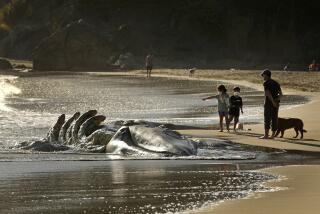Gray whale recovery called incorrect
- Share via
The success story of the Pacific gray whales’ full recovery from near-extinction is wrong, according to a new genetic analysis that pegs the current population at only one-third to one-fifth of historical levels.
By examining subtle variations in DNA taken from 42 modern whales, scientists have concluded that between 78,500 and 117,700 gray whales lived before the heyday of commercial whaling in the 19th and 20th centuries.
That finding, published today in the Proceedings of the National Academy of Sciences, suggests that the about 22,000 gray whales now swimming along the California coast remain a depleted population.
“It’s startling for us to consider the California gray whale, which we considered recovered for more than a decade, has not recovered after all,” said Scott Baker, a researcher at Oregon State University’s Marine Mammal Institute in Newport, Ore., who was not involved in the study.
The results counter what had been a predominant scientific view that the iconic creatures of the West Coast were so bountiful that they were overgrazing their traditional feeding grounds.
Instead, the findings provide further evidence that this year’s abnormally high number of skinny whales is a sign of deterioration of the vast ocean ecosystem that stretches from Baja California to the Bering Sea.
“If the oceans a few hundred years ago could support 100,000 gray whales, why can’t the oceans sustain 20,000 whales today?” said Stephen Palumbi, a Stanford University marine sciences professor and senior author of the study.
Palumbi caused a scientific commotion four years ago when he and a Harvard University colleague estimated that humpback, fin and minke whales in the North Atlantic were once two to 10 times more abundant than their current population levels.
Besides challenging conventional estimates, their study presented a political problem for the International Whaling Commission, which oversees a global ban on commercial hunting.
The commission has long promised to allow whaling nations such as Japan and Norway to resume operations once certain species have recovered to 54% of historic levels.
In the case of humpback whales, Palumbi estimated that it would take 70 to 100 years before the population reached such a threshold.
Gray whales are now hunted by native peoples, who are allowed to kill up to 140 animals each year. Nearly all are harpooned by traditional Russian hunters off the coast of Siberia, although Washington state’s Makah tribe has been trying to reassert its right to hunt gray whales.
The DNA-based estimates of historical populations are unlikely to change those limits, which most experts agree is not high enough to affect the stability of the whale population.
But the new DNA-based estimates undermine the scientific foundation of the whaling commission’s estimates of the health of whale populations in general.
“It’s going to prompt both the IWC and the National Marine Fisheries to reconsider this,” Baker said. “Whether it will convince them to change management, I’m not sure.”
Even judging by anecdotal sources, the current gray whale population is a far cry from the past. When French explorer Jean-Francois La Perouse sailed into Monterey Bay in the 1700s, he complained that gray whales were so abundant that the stench of their breath fouled the air.
The whales were nearly hunted to extinction in the 1930s, but due to international protections their population steadily increased to an estimated high of 26,600 in the late 1990s.
Scientists have previously relied on whalers’ logbooks and records of sales of barrels of oil -- and, more recently, computer models -- to estimate past populations of the behemoths. The methods were crude, producing estimates ranging from 15,000 to 20,000, though some models generated figures several times as high.
To construct a more precise estimate, Palumbi relied on the genetic principle that mutations accumulate slowly over time in a discernible pattern.
He and his colleagues, graduate students Liz Alter of Stanford and Eric Rynes of the University of Washington, examined DNA samples from 42 gray whales that had washed ashore or were biopsied at sea. They looked in 10 specific places that they believe have mutated independently over time.
Since mutations accumulate slowly, the degree of difference between the whales works as a kind of yardstick, indicating how many generations have passed since they shared a common ancestor.
The researchers used computers to calculate the number of ancient breeding whales that would have been necessary to produce the variety of genetic patterns obtained in their samples.
Factoring in that some adults don’t breed, the proportion of juveniles and other factors, they concluded that at least 78,500 and no more than 117,700 gray whales must have roamed the Pacific.
Palumbi said that population was reached at least 1,600 years ago. He said there was no way to tell if the population was stable until the onset of commercial whaling or if it had already been declining due to aboriginal hunting or unknown natural causes.
Rob Fleischer, who heads the Center for Conservation and Evolutionary Genetics at the National Zoo in Washington, D.C., said the study was convincing because of its detailed genetic analysis.
The population estimates are “still a lot more than anybody thought, even at the bottom end of the distribution,” he said.
The new study, which was funded by the National Institutes of Health, Stanford and several private foundations, has not generated the scientific skepticism of Palumbi’s first effort to use genetics to estimate the populations of humpback, fin and minke whales.
Phillip Clapham, a leading whale researcher in the National Marine Mammal Lab in Seattle and vocal critic of the first population genetic study, said the low end of the new estimated range nearly overlaps with a few of the traditional estimates.
Regardless of the historical number of gray whales, the oceans have changed since the days when “humans started killing them and mucking with their ecosystem,” he said.
The gray whale population plummeted to 17,400 after starving whales began washing ashore in 1999 and 2000.
Scientists believe the rapid warming of Arctic waters has frayed a seafloor carpet of crustaceans in the Bering Sea that has long been a food staple for gray whales.
The skinny whales are back this year, along with a further retreat of the crustaceans.
“Setting a larger recovery target based upon environmental conditions several centuries ago is kind of irrelevant if the modern ecosystem can’t support that many animals,” Clapham said.
--
More to Read
Sign up for Essential California
The most important California stories and recommendations in your inbox every morning.
You may occasionally receive promotional content from the Los Angeles Times.











